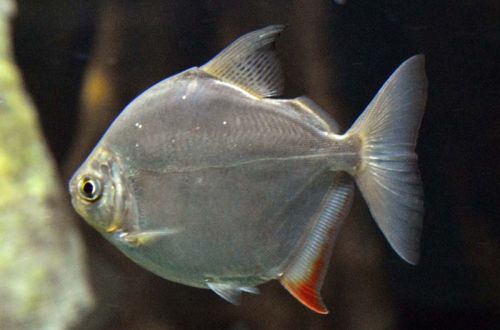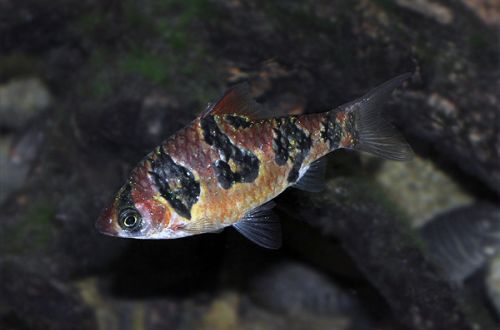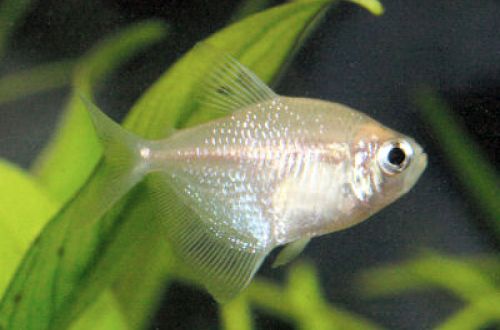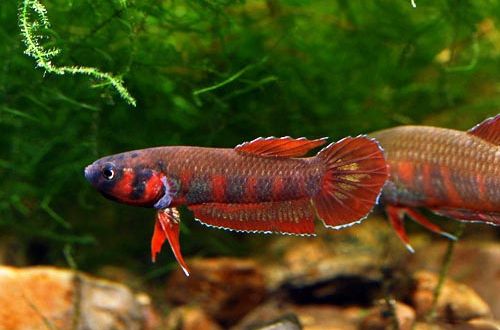
Metinnis vulgaris
Metinnis ordinary, scientific name Metynnis hypsauchen, belongs to the family Serrasalmidae (Piranidae). It is a close relative of the formidable piranhas, but has a more peaceful disposition. It belongs to a group of fish called the Silver Dollar, which also includes such popular aquarium species as Metinnis Spotted, Metinnis Lippincotta and Silvery Metinnis.

Contents
Description
Adult individuals reach a length of 15–18 cm. The fish have a high rounded body flattened from the sides. The main color is silvery, the fins and tail are translucent. Outwardly, it is almost identical to the Silver Metinnis, with the exception of the presence of a small dark spot located behind just above the eyes.
Males differ from females in having a reddish anal fin and darker coloration during the breeding season.
Brief information:
- The volume of the aquarium – from 300 liters.
- Temperature – 24-28°C
- Value pH — 6.0–7.0
- Water hardness – soft (up to 10 dH)
- Substrate type – any
- Lighting – subdued
- Brackish water – no
- Water movement – light or moderate
- The size of the fish is 15–18 cm.
- Nutrition – foods with a high content of plant components
- Temperament – peaceful
- Keeping in a group of 4-5 individuals
Habitat
Comes from South America. It is found in most tropical rivers of the continent from Guyana to Paraguay, including the vast Amazon basin. Inhabits areas of rivers with dense aquatic vegetation.
Maintenance and care, decoration of the aquarium
Optimal conditions are achieved in warm soft water with low hardness values. For a group of 4-5 individuals, you will need an aquarium of 300 liters or more. In the design, it is necessary to provide places for shelters in the form of thickets of plants. However, it should be borne in mind that Metinnis ordinary tends to damage the soft parts of plants, so it is advisable to use fast-growing species with hard foliage, or limit yourself to artificial vegetation. The lighting is subdued.
Aquarium maintenance is standard. The obligatory minimum consists of weekly replacement of part of the water with fresh water (with the same pH and dH values), removal of organic waste, cleaning the walls of the tank from plaque and design elements (if necessary), equipment maintenance.
Food
The basis of the daily diet should be feed with a high content of plant components, or separately fed plant-based supplements, for example, in the form of flakes, granules. They also accept live or frozen foods such as bloodworms, brine shrimp, etc.
They can eat smaller aquarium neighbors, fry.
Behavior and Compatibility
It is recommended to maintain a group size of 4-5 individuals. Peacefully tuned to other large species, but small fish will be under threat. Metinnis ordinary inhabits mainly the middle and upper layers of water, so fish that live near the bottom will be good companions. For example, catfish from the Plecostomus and Bronyakovs.
Breeding / breeding
Spawning is more likely in soft acidic water environments around 28°C. With the onset of the breeding season, males acquire darker shades, and redness appears in the chest area. After a short courtship, the fish lay several tens of eggs, scattering them above the soil surface without forming a clutch.
As a rule, adult fish do not eat their own eggs. However, other inhabitants of the aquarium will enjoy them with pleasure. To save the brood, it is desirable to transfer the eggs to a separate tank. The fry appear after three days. At first, they feed on the remains of their yolk sac, and only then begin to swim freely in search of food. Feed with specialized powdered feed, suspensions for feeding juvenile aquarium fish.
Fish diseases
The main cause of most diseases is the content in the wrong environment. In the case of the first symptoms, it is necessary to check the quality and hydrochemical composition of the water, if necessary, bring all the indicators back to normal and only then proceed to treatment. Read more about symptoms and treatments in the Aquarium Fish Diseases section.




